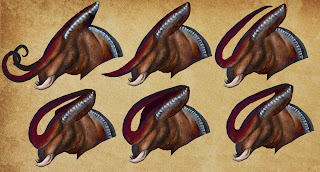I've also been reading my encyclopaedia of mythical creatures, and the ones I note down are starting to come together to form interesting creatures in their own right. For my next designs I want to develop interesting relationships and dynamics between multiple creatures, and make sure they stand alone as at least partly recognisable in mythology, though subverted.
Sketches
Concepts of the Donestre, a creature said to have a man's body and a lion's head. When it kills and devours someone, it eats up to the head and then sobs over it. The bottom right is an idea for a manticore, a lion-bodied creature with the face of a man; I wanted a different twist to simply replacing its whole head with a human's.
Concepts for a tar/marsh-dwelling stag-like creature. Long legs enable it to reach the bottom of the viscous material and wade through. Locals treat it as a curious god, and place masks on its faceless antlers to show their respect. Lower sketches are various shape explorations.
Main idea; creating a small shape in red brush pen, and working around it with the fineliner. It made for some really interesting shapes and I'd like to work on a few of them. The bottom black sketches are exploring a creature that dips its front feet in tar to bind them together, possibly to give it a more formidable strike.
Continuing with previous idea. Also considering field-based griffins; kestrel/rabbit/secretary bird hybrids. Lower black sketches are working within the boundaries of the dry brush effect I had, and looking for shapes.
Spiders and mushrooms were a vague inspiration for some here. The lower right images are built from more complex red brush pen shapes, and outlined with the slightly darker red fineliner. It's a very interesting way to add slight detail without detracting from the silhouette.
Top: idea for a 'mother' creature, which spirits away babies of other creatures, and murders the guardian. Heads of such guardians are kept alive on spines on its back, using protrusions like ribbon-worm tongues to latch into the nerves and keep it 'alive'. Possibly its head is capable of 360 degrees like an owl, so it could place a chosen head from its collection onto a prong and wear it to interact with its 'child'.
Lower: Unicorns. Based on the idea of them having lion-like traits (tail, mane) in heraldry, and pushing it further to make them a more predatory animal.
Lathrid creatures. Possibly to take the role of mounts in the world I want to design in my next project. Chameleon-like feet for grip when climbing, and a love of shiny jewelry and piercings. The bottom headshot is from this creature design, made to add notes to whilst researching.
Drawn when there were no computers free at university. Randomised sets of three animals were written down from an internet generator, and then I used what knowledge I had of the animals to try and make interesting creatures. The rat/warthog was a particular favourite, as was the dingo/bighorn sheep. It made me consider simpler ideas for future designs, and the range of sizes my creatures could be.
Sketches working out how a two-headed dog like Orthos might be made different. Its second head is tucked up in its neck, with its jaws resting behind the main head's. The lower sketches are from this creature design, looking for a pose.
More ideas for Orthos. The idea of an imperfect, chimeric double face like Janus is considered, but it seems an easy conclusion. Also designed a snake (began as a lizard) that lurks as a branch, with a flower-like mouth, to lure in prey. It has a relationship with leaf-like bugs that rest on it without fear, looking like buds and adding more credibility to the creature being a real branch. In turn they are protected from animals that might try to eat them. Additionally, I was watching a documentary that featured dinosaurs with pressure sensors, and titanic herbivores that grew due to expending little energy and taking in vast amounts. I feel they will add to future designs.
Reflection
- Need to do more watercolour, and possibly extend the range of colours used. Maybe gouache or acrylic, too.
- Definitely want to model with clay in the near future.
- I swap between brush pen, fineliners, and pencil; sometimes it's from using one constantly, and I want a change, but mostly I use the tool I feel is best for what I'm trying to achieve. Pencil is for sketching ideas of creatures I have a better sense of and can put details onto, whilst the brush pen is for blocking out shapes and finding interesting silhouettes, which the fineliner can begin the detailing on.
- Articles and documentaries are useful in ways I didn't imagine, as they give a trivial piece of information that could shape a whole creature design.















